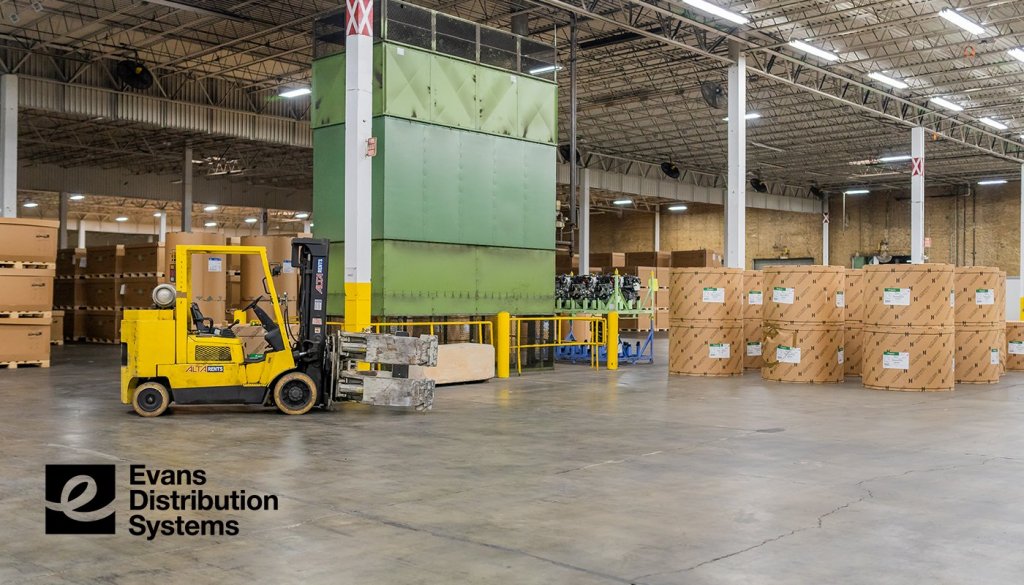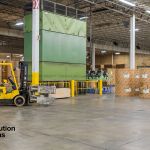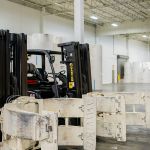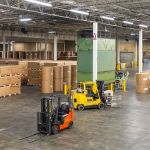
Paper—we use it in our daily lives. This is an important commodity that comes in many forms and functions. From plates, napkins, straws, stationary, toilet paper, paper towels, packaging, boxes, and more. As a society, we rely heavily on paper and pulp-based products.
According to a January 2020 Marketing Analysis Report by Grandview Research, the global paper market is expected to reach $275.1 billion by 2025. This growth is largely due to rising demand in the pharmaceutical, fast-moving consumer goods and hospitality industries.
Currently, Evans services five paper mill and manufacturers in our warehousing and transportation divisions. Over the years, we have become accustomed to serving this industry and we have built strong partnerships with our customers and service partners.
Paper & Pulp Challenges
The paper and pulp industry is unique for several reasons. First, paper varies by diameter and weight. Often they are packaged as oversized rolls that can weigh from 1,700 to 4,000 pounds. Rail is the most cost effective way to transport paper.
Evans’ rail-served facilities are ideal for paper customers who utilize that mode of transportation because they don’t require drayage. These customers require consistent unloading of rail cars as they arrive at the warehouse. On some paper accounts, Evans employees unload up to 6 rail cars per day with 60 rolls in each car.
“Associates need to be mindful when unloading rail cars. During transportation the paper tends to compress to one side or hit the sides of the car. Our forklift operators are very careful when unloading a car to reduce further damage,” says Pat Bledsoe, Operations Manager at Evans.
The oversized rolls of paper require a special forklift clamp that grips the loads from the side and carries them out of the rail cars. But the rolls are delicate. If they are clamped too tightly, the paper will damage.
“You need the right training and forklift skills to unload those rolls correctly,” says Jennifer Bershaw, 3PL Warehouse Manager at Clearwater Paper Corporation. “You want the least amount of damage as possible because our customers want to process it quickly. They don’t want to have to peel away lots of layers of damage. Evans has always done a wonderful job of training.”
There’s also the issue of demurrage. Rail lines charge additional fees when cars are not unloaded within a certain time frame. The rail industry is known to be unpredictable on delivery. Demurrage charges can add up quickly with a high-volume product like paper. “Evans watches our bottom line,” Bershaw says. “They work with rail providers to track cars and anticipate the need for overtime to have cars unloaded and keep demurrage costs low.”
If paper is light enough to be lifted by a traditional forklift, it can be braced on cardboard or wood planks. These can be lifted from the bottom and transported carefully.
In addition to requiring delicate handling, paper is susceptible to damage from moisture. This requires a daily inspection of the warehouse for signs of moisture. Associates also inspect any other debris that the paper might have accumulated on its journey over. “We inspect for rocks or pebbles that could potentially damage the product,” Bledsoe says.
Location, Flexibility & Speed
Clearwater Paper utilizes Evans for a number of reasons. According to Bershaw, the paper industry functions on a just-in-time format. “The customer doesn’t want to hold a lot of product on the floor and providing expedited services is highly valuable,” Bershaw says. Her team directs inventory to Evans’ facilities so they can accommodate 24-hour lead times or same-day deliveries that are requested by Clearwater’s customers.
Evans Logistics Inc. transports a high daily volume of inbound and outbound paper truckloads. According to Deanna Smith, Transportation Supervisor at Evans, there are several advantages to having a full-service transportation management solution.
- Flexibility—Paper is a high demand commodity with dramatic volume increases and decreases. “We often are sought out by our paper partners to accommodate same-day deliveries to ensure that the manufacturing line is not disrupted. We handle these last-minute requests quickly and reliably, time after time,” Smith says.
- Communication—When communication between the transportation and warehouse operations is internal, the visibility and transparency can speed up reaction time. “We have more success with keeping each service area in the loop when adjustments are needed or new loads arise,” Smith says. Also, serving paper customers in the same WMS and TMS systems creates a fluid information flow between the operations, customer service and logistics coordinators. All parties are knowledgeable about customer requirements from the start.
- Transportation Partnerships—”Evans has partnerships with trusted carriers who can react quickly to our short lead times,” Bershaw says. “We work with drivers who are experienced and knowledgeable about our paper accounts. The same drivers are utilized each time and know the contacts on their routes, making the delivery process seamless,” Smith says.
Evans’ Solution
Years of experience storing and transporting paper has given Evans an advantage. Paper is an essential commodity that has only grown in importance in our lives. Manufacturers need to trust their 3PL partners to keep products safe while in their care and delivered quickly. Evans continues to make the process easy every step of the way with our paper and pulp customers.
“You think paper is easy but it’s really an art form,” says Bershaw. “We have been able to flex by thousands of tons of inbound and outbound shipments over the years with Evans. They are one of our most trusted and reliable 3PL partners.”




